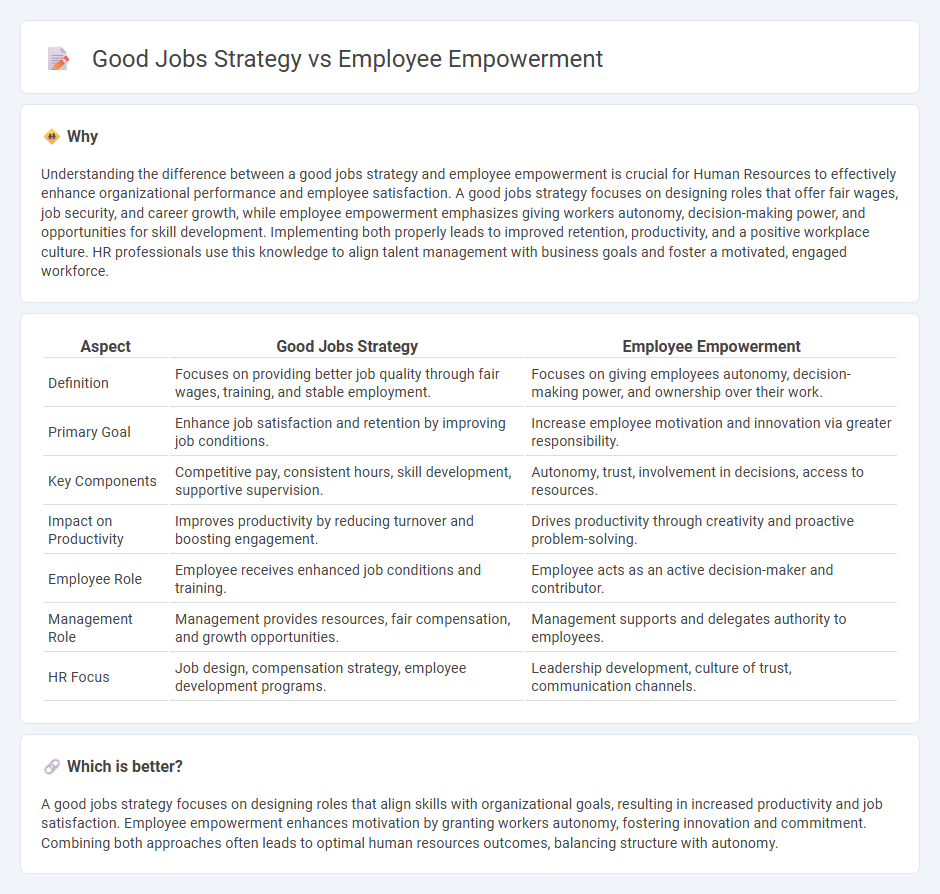
Effective human resources strategies balance structured job frameworks with employee empowerment to enhance productivity and job satisfaction. Companies that implement clear role definitions alongside autonomy and development opportunities see higher engagement and retention rates. Discover how integrating both approaches can transform your workforce dynamics.
Why it is important
Understanding the difference between a good jobs strategy and employee empowerment is crucial for Human Resources to effectively enhance organizational performance and employee satisfaction. A good jobs strategy focuses on designing roles that offer fair wages, job security, and career growth, while employee empowerment emphasizes giving workers autonomy, decision-making power, and opportunities for skill development. Implementing both properly leads to improved retention, productivity, and a positive workplace culture. HR professionals use this knowledge to align talent management with business goals and foster a motivated, engaged workforce.
Comparison Table
| Aspect | Good Jobs Strategy | Employee Empowerment |
|---|---|---|
| Definition | Focuses on providing better job quality through fair wages, training, and stable employment. | Focuses on giving employees autonomy, decision-making power, and ownership over their work. |
| Primary Goal | Enhance job satisfaction and retention by improving job conditions. | Increase employee motivation and innovation via greater responsibility. |
| Key Components | Competitive pay, consistent hours, skill development, supportive supervision. | Autonomy, trust, involvement in decisions, access to resources. |
| Impact on Productivity | Improves productivity by reducing turnover and boosting engagement. | Drives productivity through creativity and proactive problem-solving. |
| Employee Role | Employee receives enhanced job conditions and training. | Employee acts as an active decision-maker and contributor. |
| Management Role | Management provides resources, fair compensation, and growth opportunities. | Management supports and delegates authority to employees. |
| HR Focus | Job design, compensation strategy, employee development programs. | Leadership development, culture of trust, communication channels. |
Which is better?
A good jobs strategy focuses on designing roles that align skills with organizational goals, resulting in increased productivity and job satisfaction. Employee empowerment enhances motivation by granting workers autonomy, fostering innovation and commitment. Combining both approaches often leads to optimal human resources outcomes, balancing structure with autonomy.
Connection
Effective job strategies in Human Resources directly influence employee empowerment by aligning roles with individual strengths and offering growth opportunities. Empowered employees demonstrate increased engagement, productivity, and innovation, driving organizational success and retention rates. Strategic workforce planning ensures that job designs maximize autonomy and decision-making, fostering a culture of trust and accountability.
Key Terms
Employee Empowerment:
Employee empowerment enhances job satisfaction by granting workers autonomy, decision-making authority, and opportunities for skill development, which boosts productivity and innovation. This approach creates a workplace culture that values trust and accountability, leading to higher employee engagement and retention rates compared to traditional good jobs strategies focused solely on wages and benefits. Discover how employee empowerment transforms organizational performance and worker well-being.
Autonomy
Employee empowerment emphasizes granting workers autonomy to make decisions, fostering innovation and job satisfaction. The good jobs strategy prioritizes autonomy alongside fair wages and benefits to create sustainable, high-quality employment. Explore how balancing autonomy within these approaches drives organizational success and employee well-being.
Decision-Making
Employee empowerment centers on granting workers autonomy in decision-making, enhancing engagement and productivity. The good jobs strategy emphasizes providing fair wages, benefits, and job security alongside decision-making authority to foster long-term employee satisfaction and retention. Explore how integrating these approaches can transform workplace dynamics and drive organizational success.
Source and External Links
Employee Empowerment: Definition, Benefits, and Examples - This webpage provides insights into employee empowerment, including its definition, benefits, and strategies such as training and development, encouraging feedback, and supporting workplace culture.
Employee Empowerment: Benefits and Strategies - This article discusses the benefits of employee empowerment and outlines strategies for implementation, including showing that feedback matters, recognizing employee contributions, and providing growth opportunities.
8 Powerful Examples of Employee Empowerment at Work - This blog post highlights examples of employee empowerment, such as involving employees in decision-making and focusing on recognition and rewards, to boost productivity and motivation.
 dowidth.com
dowidth.com